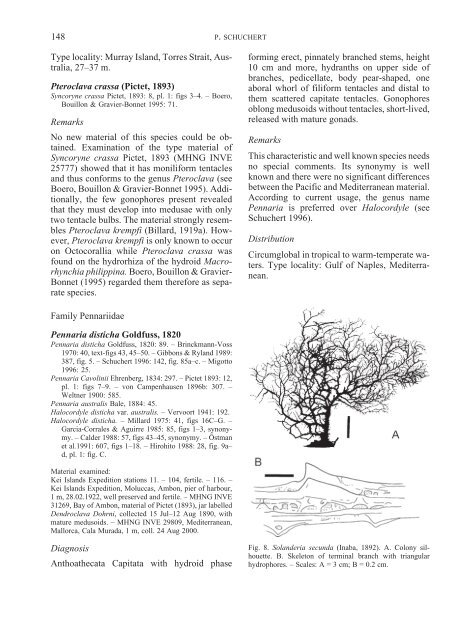Hydroids (Cnidaria, Hydrozoa) of the Danish expedition to
Hydroids (Cnidaria, Hydrozoa) of the Danish expedition to
Hydroids (Cnidaria, Hydrozoa) of the Danish expedition to
You also want an ePaper? Increase the reach of your titles
YUMPU automatically turns print PDFs into web optimized ePapers that Google loves.
148<br />
Type locality: Murray Island, Torres Strait, Australia,<br />
27–37 m.<br />
Pteroclava crassa (Pictet, 1893)<br />
Syncoryne crassa Pictet, 1893: 8, pl. 1: figs 3–4. – Boero,<br />
Bouillon & Gravier-Bonnet 1995: 71.<br />
Remarks<br />
No new material <strong>of</strong> this species could be obtained.<br />
Examination <strong>of</strong> <strong>the</strong> type material <strong>of</strong><br />
Syncoryne crassa Pictet, 1893 (MHNG INVE<br />
25777) showed that it has moniliform tentacles<br />
and thus conforms <strong>to</strong> <strong>the</strong> genus Pteroclava (see<br />
Boero, Bouillon & Gravier-Bonnet 1995). Additionally,<br />
<strong>the</strong> few gonophores present revealed<br />
that <strong>the</strong>y must develop in<strong>to</strong> medusae with only<br />
two tentacle bulbs. The material strongly resembles<br />
Pteroclava krempfi (Billard, 1919a). However,<br />
Pteroclava krempfi is only known <strong>to</strong> occur<br />
on Oc<strong>to</strong>corallia while Pteroclava crassa was<br />
found on <strong>the</strong> hydrorhiza <strong>of</strong> <strong>the</strong> hydroid Macrorhynchia<br />
philippina. Boero, Bouillon & Gravier-<br />
Bonnet (1995) regarded <strong>the</strong>m <strong>the</strong>refore as separate<br />
species.<br />
Family Pennariidae<br />
Pennaria disticha Goldfuss, 1820<br />
Pennaria disticha Goldfuss, 1820: 89. – Brinckmann-Voss<br />
1970: 40, text-figs 43, 45–50. – Gibbons & Ryland 1989:<br />
387, fig. 5. – Schuchert 1996: 142, fig. 85a–c. – Migot<strong>to</strong><br />
1996: 25.<br />
Pennaria Cavolinii Ehrenberg, 1834: 297. – Pictet 1893: 12,<br />
pl. 1: figs 7–9. – von Campenhausen 1896b: 307. –<br />
Weltner 1900: 585.<br />
Pennaria australis Bale, 1884: 45.<br />
Halocordyle disticha var. australis. – Vervoort 1941: 192.<br />
Halocordyle disticha. – Millard 1975: 41, figs 16C–G. –<br />
Garcia-Corrales & Aguirre 1985: 85, figs 1–3, synonymy.<br />
– Calder 1988: 57, figs 43–45, synonymy. – Östman<br />
et al.1991: 607, figs 1–18. – Hirohi<strong>to</strong> 1988: 28, fig. 9a–<br />
d, pl. 1: fig. C.<br />
Material examined:<br />
Kei Islands Expedition stations 11. – 104, fertile. – 116. –<br />
Kei Islands Expedition, Moluccas, Ambon, pier <strong>of</strong> harbour,<br />
1 m, 28.02.1922, well preserved and fertile. – MHNG INVE<br />
31269, Bay <strong>of</strong> Ambon, material <strong>of</strong> Pictet (1893), jar labelled<br />
Dendroclava Dohrni, collected 15 Jul–12 Aug 1890, with<br />
mature medusoids. – MHNG INVE 29809, Mediterranean,<br />
Mallorca, Cala Murada, 1 m, coll. 24 Aug 2000.<br />
Diagnosis<br />
Anthoa<strong>the</strong>cata Capitata with hydroid phase<br />
P. SCHUCHERT<br />
forming erect, pinnately branched stems, height<br />
10 cm and more, hydranths on upper side <strong>of</strong><br />
branches, pedicellate, body pear-shaped, one<br />
aboral whorl <strong>of</strong> filiform tentacles and distal <strong>to</strong><br />
<strong>the</strong>m scattered capitate tentacles. Gonophores<br />
oblong medusoids without tentacles, short-lived,<br />
released with mature gonads.<br />
Remarks<br />
This characteristic and well known species needs<br />
no special comments. Its synonymy is well<br />
known and <strong>the</strong>re were no significant differences<br />
between <strong>the</strong> Pacific and Mediterranean material.<br />
According <strong>to</strong> current usage, <strong>the</strong> genus name<br />
Pennaria is preferred over Halocordyle (see<br />
Schuchert 1996).<br />
Distribution<br />
Circumglobal in tropical <strong>to</strong> warm-temperate waters.<br />
Type locality: Gulf <strong>of</strong> Naples, Mediterranean.<br />
Fig. 8. Solanderia secunda (Inaba, 1892). A. Colony silhouette.<br />
B. Skele<strong>to</strong>n <strong>of</strong> terminal branch with triangular<br />
hydrophores. – Scales: A = 3 cm; B = 0.2 cm.

















